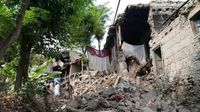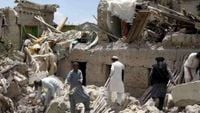As the dust settles over the rugged mountains of eastern Afghanistan, a humanitarian crisis of staggering proportions is unfolding. On September 9, 2025, the United Nations issued an urgent appeal for $139 million to support the nearly half a million people whose lives have been upended by a series of devastating earthquakes in Kunar, Nangarhar, and Laghman provinces. The tremors, which struck on the night of August 31 into September 1 and were followed by powerful aftershocks, have left entire villages flattened, thousands of families homeless, and the international community scrambling to respond before the harsh Afghan winter sets in.
According to the UN Office for the Coordination of Humanitarian Affairs (OCHA), the earthquakes have affected at least 457,000 people across Kunar, Nangarhar, Laghman, and Nuristan. The Taliban government has reported that more than 2,200 people lost their lives in the disaster, with over 3,600 injured and upwards of 6,700 homes destroyed or severely damaged. As families huddle in makeshift shelters or under the open sky, the nighttime temperatures are already beginning to drop, raising fears that the coming winter could prove deadly for those who remain without adequate shelter or supplies.
“This is a moment when the international community must stand in solidarity with a population that has already suffered so much,” said Indrika Ratwatte, the UN Humanitarian Coordinator for Afghanistan, during a briefing in Geneva. His plea was clear and urgent: “Lives are at stake, and within two or three weeks winter temperatures will reach these high-altitude communities.” Ratwatte’s words, reported by Reuters and other outlets, underscore the narrow window of opportunity for aid agencies to deliver life-saving assistance before snow and ice cut off remote mountain villages.
The United Nations’ emergency plan, outlined by OCHA, is designed to run for four months and prioritizes shelter, food, healthcare, and psychosocial support for the affected population. The situation on the ground is dire. Entire villages have been reduced to rubble, food stocks are depleted, and essential services have been disrupted. Families are living in fear of further landslides, and the psychological toll of the disaster is mounting. The UN has warned that, without swift and substantial international support, Afghanistan’s fragile humanitarian situation could deteriorate even further, leading to more deaths and displacement as winter approaches.
Yet, delivering aid in Afghanistan is no simple task. The country’s humanitarian response capacity has been sharply curtailed, with donor funding down 35 percent since 2024. This reduction includes significant cuts from the United States, according to Ratwatte. The funding shortfall has already had tangible consequences: a helicopter that once ferried aid workers and supplies to hard-to-reach mountain communities now sits grounded due to lack of resources. “Our appeal has always been to focus on the people,” Ratwatte said, emphasizing the need for donors to set aside political reservations about Afghanistan’s de facto authorities—the Taliban—and prioritize the immediate needs of civilians.
Political considerations, however, continue to cast a long shadow over the relief effort. Many governments remain hesitant to funnel aid through channels that might empower the Taliban, particularly given the group’s restrictive policies toward women. The World Health Organization has called on the Taliban to lift bans that prevent Afghan female aid workers from traveling without a male guardian. Humanitarian organizations say that female staff are essential to reaching women and children in Afghanistan’s conservative communities, where cultural norms often bar male workers from entering private homes.
“Our aim is to have at least one woman in every response team,” Ratwatte explained. “At present that is not possible everywhere, and we are working to address this gap.” The challenge is not merely logistical but deeply rooted in the country’s social and political landscape. The absence of female aid workers restricts access to vulnerable groups and hampers the effectiveness of relief operations. Despite these obstacles, UN partners are already on the ground, providing urgent assistance to women, children, and men in the affected provinces.
The scale of the disaster is almost unfathomable. More than 2,200 people are confirmed dead, and the true toll may be even higher as some areas remain inaccessible. Over 6,700 homes have been destroyed, forcing families to endure harsh conditions without proper shelter. Food insecurity is mounting as local stocks dwindle, and the disruption of essential services threatens to push the region deeper into crisis. Aid agencies fear that, without immediate international support, the winter months could bring a second wave of tragedy to communities that have already lost so much.
The United Nations’ emergency appeal is not just a call for funds—it is a plea for global solidarity. “This is a moment where the international community must dig deep and show solidarity with a population that has already endured so much suffering,” Ratwatte told reporters. The message is echoed by humanitarian groups and observers, who warn that the consequences of inaction could be catastrophic.
Despite the challenges, there are glimmers of hope. The UN’s four-month emergency program aims to provide shelter, food aid, healthcare, and psychosocial support to 457,000 people, with the goal of preventing further deaths and displacement. The focus is on delivering assistance quickly and efficiently, before winter weather makes access to remote areas impossible. The plan also includes efforts to address the specific needs of women and children, recognizing the unique vulnerabilities faced by these groups in times of crisis.
But time is running out. With winter just weeks away, the window for effective intervention is closing fast. The international community faces a stark choice: act now to prevent a humanitarian catastrophe, or risk bearing witness to yet another tragedy in a country that has already suffered more than its share. The UN’s appeal for $139 million is not just a request for money—it is a test of the world’s commitment to the people of Afghanistan at their hour of greatest need.
As the world watches, the fate of hundreds of thousands of Afghans hangs in the balance, awaiting a response that could mean the difference between survival and despair.


